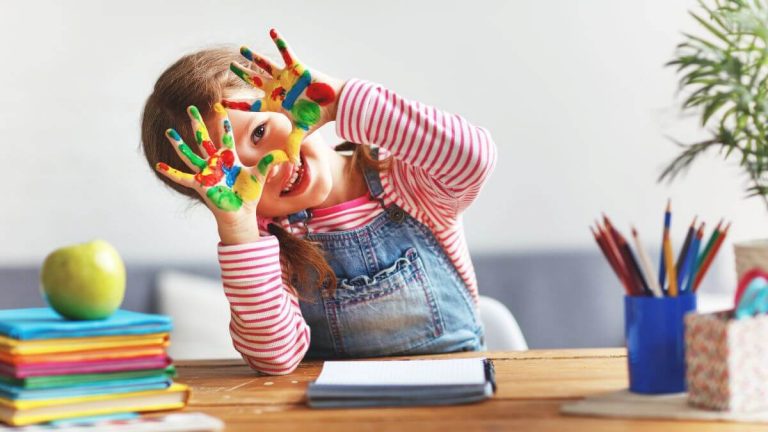6 Surprising Benefits of Painting for Children Every Parent Should Know


Introduction
As parents, we’re on a perpetual quest to provide our children with opportunities for growth and development. Among modern life’s hustle, one timeless activity often overlooked is painting. Putting brush on canvas or paper isn’t just about creating beautiful art; it’s a profound experience that influences a child’s cognitive, emotional, and physical development.
The benefits of painting include improved cognitive skills, enhanced emotional well-being, fine motor development, nurturing creativity, art therapy potential, and educational enrichment.
In this extensive guide, we’ll delve deep into these benefits. So, let’s embark on this journey to understand why painting is vital to your child’s growth.
Before diving into the rich tapestry of benefits that painting provides, it’s essential to lay the foundation by understanding why this creative endeavor is integral to a child’s overall development. Painting isn’t merely a leisure activity; it’s a multifaceted experience that engages various facets of a child’s growth. Let’s get into six profound advantages of painting that every parent should be aware of.
It might be a surprise, but painting is a masterful tool for honing your child’s problem-solving skills. When children embark on a painting project, they step into decision-makers’ shoes. Questions arise: What colors should they use to convey their vision? How do they translate their ideas into a visual masterpiece? This decision-making process compels them to think critically and seek innovative solutions to the artistic challenges they encounter.
Painting is more than mere creative expression; it’s akin to solving a puzzle that requires logical thinking and organization. Crafting a coherent and visually appealing piece demands planning, organization, and creative problem-solving—skills significantly contributing to a child’s critical thinking abilities.
Have you ever observed the unwavering concentration that envelops your child during a painting session? It’s not just artistic dedication; it’s a powerful tool for enhancing their concentration and attention span. The ability to delve deeply into a task extends beyond the canvas, benefiting their academic pursuits and various activities.
In today’s fast-paced world, stress can affect children too. Painting offers a therapeutic escape route. It allows them to unwind, destress, and momentarily detach from the pressures of daily life. The emotional release that painting provides can be instrumental in helping children manage stress and anxiety.
Children, especially younger ones, may not always have the words to articulate their emotions effectively. However, through painting, they can communicate their feelings with remarkable clarity. Translating their emotions into visual art helps them express themselves and fosters profound self-esteem as they witness their emotions taking tangible form on paper.
The positive feedback loop created by the appreciation of their artistic creations profoundly impacts a child’s self-confidence. When they realize their work is valued and celebrated, it instills a sense of accomplishment that resonates across various facets of their life.
Engaging in painting requires precise movements and coordination. Using small brushes and the careful hand movements required to create intricate details enhances your child’s precision and fine motor skills. These skills are vital for creating art and mastering everyday tasks like writing and tying shoelaces.
The process of translating mental images into physical artwork necessitates impeccable hand-eye coordination. As your child manipulates brushes and applies paint to the canvas, they naturally develop better control over their movements. This essential skill extends its influence into sports and playing musical instruments.
Fine motor skills encompass the coordination of small muscle groups, and painting, with its intricate movements and attention to detail, serves as an exceptional means to foster the growth of these fine motor skills. This development is vital for tasks that demand agility and precision.
Painting serves as a portal to a realm of boundless imagination. It encourages children to dream, explore, and create without constraints. This unbridled creativity is indispensable for nurturing their imaginative faculties.
Creative thinking and problem-solving go hand in hand. The act of painting necessitates approaching challenges and artistic choices in unconventional ways. This, in turn, nurtures a child’s ability to think creatively and find innovative solutions to problems—a skill that holds value across all domains of life.
One of the most profound aspects of painting is its capacity to allow children to express themselves freely. This unfiltered self-expression is instrumental in building their self-identity and aiding them in understanding who they are at a deeper level.
Beyond its role as a creative pursuit, painting can also be a therapeutic tool for children. Art therapy, often administered by professionals, harnesses the therapeutic potential of art, including painting, to help children cope with stress, trauma, and emotional difficulties.
The meditative and calming attributes of painting make it particularly effective in assisting children in dealing with stress and anxiety. It provides a non-verbal avenue for processing complex emotions, allowing them to find solace and balance.
In some cases, painting can be a potent instrument for healing. It can facilitate emotional recovery and serve as a means of communication for children who struggle to express themselves verbally. The act of painting becomes a cathartic and transformative journey.
Painting isn’t confined to leisure and recreation; it is also an integral component of early childhood education. It plays a pivotal role in helping children acquire essential skills and prepares them for academic success.
For educators and parents alike, embracing the potential of painting is essential. Creating a nurturing environment that encourages artistic expression is critical. Providing a wide array of art supplies and allowing children to explore their creativity can profoundly impact their development.
Integrating painting into educational activities is a brilliant strategy. It can teach various subjects, from shapes and colors to historical events. Painting is a versatile tool that enhances learning by making it a vivid and engaging experience.
In conclusion, painting is not a mere frivolous pastime but a transformative journey for your child’s growth and development. By embracing painting, you empower your child to enhance their cognitive skills, nurture their emotional well-being, develop fine motor skills, foster creativity, and even find solace in times of distress.